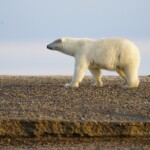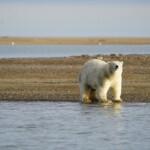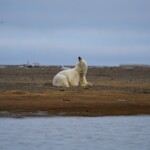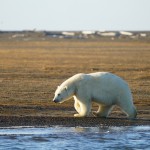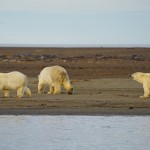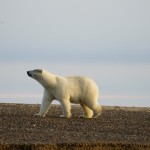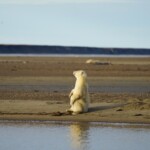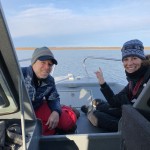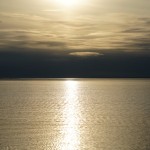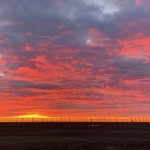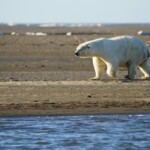Polar Bears!
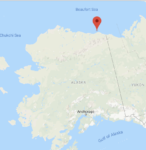 Kaktovik lies at the far northern edge of Alaska’s North Slope region, about 640 miles north of Anchorage (and almost 400 north of Fairbanks). Located on Barter Island and due to its location, is mostly cut off from the rest of the world. Everything – fuel, supplies, infrastructure, needs to be brought in either by plane (to a small, gravel, landing strip) or by barge – of which there are between 1 and 3 a season. It’s just about the farthest northern town in America (Utqiagvik, which used to be called Barrow, is slightly north of Kaktovik). During the winter, the sun doesn’t rise for 2 months. Despite this isolation – or perhaps because of it – Kaktovik is considered one of the best places in the world to see Polar Bears. Female bears with their cubs make Kaktovik their summer home (the ever receding polar ice is about 200 miles north) where they wait out the season in anticipation of the ice reforming starting in October so they can venture north to hunt seals. The town is populated primarily by Inupiat, who continue to practice some of their native traditions, including the hunting of whales (they’re allowed up to 3 a year under treaty with the US government). While they use the majority of the whale for food and other purposes, the remains are deposited in a “bone pile” that the bears feed upon. It’s also not uncommon to see a bear in the village itself.
Kaktovik lies at the far northern edge of Alaska’s North Slope region, about 640 miles north of Anchorage (and almost 400 north of Fairbanks). Located on Barter Island and due to its location, is mostly cut off from the rest of the world. Everything – fuel, supplies, infrastructure, needs to be brought in either by plane (to a small, gravel, landing strip) or by barge – of which there are between 1 and 3 a season. It’s just about the farthest northern town in America (Utqiagvik, which used to be called Barrow, is slightly north of Kaktovik). During the winter, the sun doesn’t rise for 2 months. Despite this isolation – or perhaps because of it – Kaktovik is considered one of the best places in the world to see Polar Bears. Female bears with their cubs make Kaktovik their summer home (the ever receding polar ice is about 200 miles north) where they wait out the season in anticipation of the ice reforming starting in October so they can venture north to hunt seals. The town is populated primarily by Inupiat, who continue to practice some of their native traditions, including the hunting of whales (they’re allowed up to 3 a year under treaty with the US government). While they use the majority of the whale for food and other purposes, the remains are deposited in a “bone pile” that the bears feed upon. It’s also not uncommon to see a bear in the village itself.
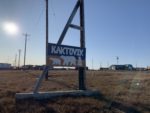 With Polar Bears in mind, Greeley and I ventured up to Kaktovik last week with Brad and Amy to see the bears and experience a few days far north (for all of us it was the farthest north we had ever been). Kaktovik is an interesting place – with a population primarily of Inupiat and at that only about 290 permanent population. But as one of two main gateways to the Arctic National Wildlife Refuge it sees some tourist traffic during the summer months. Kaktovik is a desolate place, build on top of the alpine tundra and with little in the way of vegetation. There are two small motels, no restaurants (except for the facilities in the motels themselves) and only basic infrastructure. The people were very friendly but clearly hearty and self reliant. Most had long time family ties to the area. There is a small school there as well as a US Fish and Wildlife station. Industry is either government or related to tourism (not just polar bear watching but caribou hunting and fishing). From what I could gather the town in large part exists because of the stipends that Inupiat receive from the Alaska Native Corporation (royalties received from the US government; payback in the government’s mind for stealing their lands generations ago).
With Polar Bears in mind, Greeley and I ventured up to Kaktovik last week with Brad and Amy to see the bears and experience a few days far north (for all of us it was the farthest north we had ever been). Kaktovik is an interesting place – with a population primarily of Inupiat and at that only about 290 permanent population. But as one of two main gateways to the Arctic National Wildlife Refuge it sees some tourist traffic during the summer months. Kaktovik is a desolate place, build on top of the alpine tundra and with little in the way of vegetation. There are two small motels, no restaurants (except for the facilities in the motels themselves) and only basic infrastructure. The people were very friendly but clearly hearty and self reliant. Most had long time family ties to the area. There is a small school there as well as a US Fish and Wildlife station. Industry is either government or related to tourism (not just polar bear watching but caribou hunting and fishing). From what I could gather the town in large part exists because of the stipends that Inupiat receive from the Alaska Native Corporation (royalties received from the US government; payback in the government’s mind for stealing their lands generations ago).
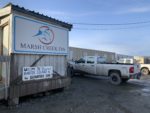
 The experience for us was fantastic. We stayed at a place called the Marsh Creek Inn, which was very basic but comfortable, run by Tim and his family who couldn’t have been more welcoming. We ate all our meals at Marsh Creek and I was impressed by the fresh salads, bananas and strawberries (when Tim received the Strawberry shipment he came out to the dining room and announced “how about that – strawberries in Kaktovik!”; he later dipped them in chocolate and served them as dessert, which was pretty awesome). As we ate or wandered through town I kept marveling at how they manage to keep all of this supplied so remotely. That and what it must be like in the dead of winter.
The experience for us was fantastic. We stayed at a place called the Marsh Creek Inn, which was very basic but comfortable, run by Tim and his family who couldn’t have been more welcoming. We ate all our meals at Marsh Creek and I was impressed by the fresh salads, bananas and strawberries (when Tim received the Strawberry shipment he came out to the dining room and announced “how about that – strawberries in Kaktovik!”; he later dipped them in chocolate and served them as dessert, which was pretty awesome). As we ate or wandered through town I kept marveling at how they manage to keep all of this supplied so remotely. That and what it must be like in the dead of winter.
Each day we ventured out to watch the bears (returning for a few hours over lunch). And they did not disappoint. Seeing a polar bear in the wild is a remarkable experience and one I’ll never forget. They are massively powerful animals, but graceful and downright cute a times. At times they were active – play fighting with each other and roaming. At others we watched them just nap. It was incredible and I’m thankful for having had the experience. I don’t typically blog about vacations or trips that I take but I thought this one was worth sharing, along with some pictures of our time there.


